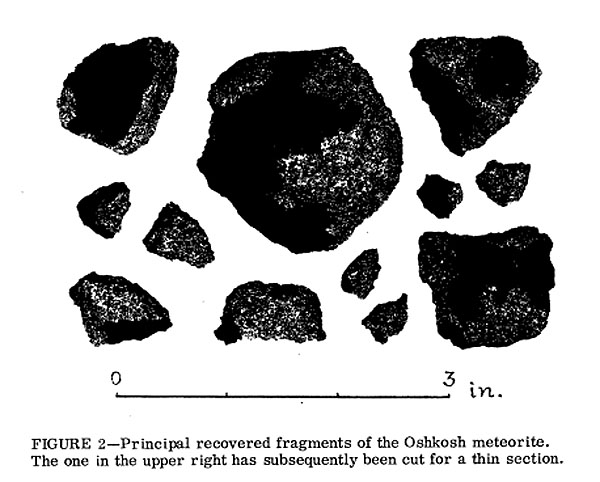The Oshkosh Meteorite Mystery Cache
BakRdz: Archiving this cache to open up space along trail for others.
Cache Rescue Mission Request Submitted through WGA.
-
Difficulty:
-

-
Terrain:
-

Size:  (small)
(small)
Related Web Page
Please note Use of geocaching.com services is subject to the terms and conditions
in our disclaimer.
Sorry…the posted coordinates are NOT the location of the
cache. I really didn't want to make this a mystery cache, but
due to the proximity of the highway and prison it was the only safe
option. But don’t run away puzzlephobes! You don’t
need to be rocket scientist to solve this one! With some close
attention to all the details, the solve will click... even
for a space cadet.

While the coordinates are NOT the site of the cache, they do mark
the approximate location of the discovery of “The Oshkosh
Meteorite” – the only known find of this kind in the
area. The story below is about the meteorite and it’s
discovery. It’s a perfect lesson for geocachers…You
never know what surprises you’ll discover if you keep your
eyes peeled when looking for something else.
In the fall of 1961, Ronald C. Meyer of Appleton was a college
freshman at what was then known as Wisconsin State University,
Oshkosh. On September 17th, he decided to hitchhike down Highway 41
to spend the weekend at home. As he waited for a ride near this
spot, he passed the time by picking up stones and tossing them at
the nearby billboards. As he picked up one of the rocks, he noticed
it was different. It reminded him of the fragments of a meteorite
he had seen at an exhibit at Lawrence University when he was in
high school the year before. He put the fragment, along with others
like it he had found in the vicinity, into his pocket. Upon
reaching home, he immediately mailed one of the fragments to
Professor William F. Read of Lawrence University’s Geology
Department where it was confirmed…Mr. Meyer had found
fragments of a meteor. On September 25th, Mr. Meyer took Prof. Read
to the vicinity of the find to search for additional fragments.
Unfortunately, additional and future studies only yielded one
additional small fragment and no witnesses to the entry, known as a
fall, were ever found. A 1-gram fragment was given to the American
Museum of Natural History for study. The remaining fragments were
reported to be deposited in the U.S. National Museum.
About the meteorite: A total of 12 fragments weighing 144.8
grams were discovered between Mr. Meyer and Prof. Read. At the
time, the fragments were identified as an olivine-bronzite
chondrite. Today, these are officially known as H chondrites. H
chondrites are part of the ordinary chondrite family and have
higher iron contents and smaller chondrules than the other types of
ordinary chondrites, L and LL. About 80% of all meteorite falls are
ordinary chondrites with about 40% percent of them considered H
chondrites.
Using math to find the cache: (for those who
want to do it the hard way)
A = Amount of days between the first discovery and the secondary
search.
B = Number of fragments picked up in the initial discovery.
X = Number of ordinary chondrites classifications that are NOT H
chondrites.
Y = Percentage of all meteorite falls that are H chondrites.
For the new NORTH coordinates:
• Add A times B to the last three numbers of the given North
coordinates.
For the new WEST coordinates:
• Add X to the 2-digit number on the LEFT side of the decimal
in the given West coordinates.
• Take Y% of the 3-digit number on the RIGHT side of the
decimal in the given West coordinates, double that number and round
down to the nearest whole number.
For anyone who really feels the need, check your math
here.
Take care with discovering, retrieving, and replacing the cache to
save the experience for others. Spoilers in the logs will be
immediately deleted. Thanks for your understanding…and
Happy Hunting!
NOTE: The final is placed along the Wiouwash Trail.
Geocaches placed on Wisconsin Department of Natural Resource
managed lands require permission by means of a notification form. A
Geocache Notification Form for this cache such as the completed one
here was not submitted to the office of the Wisconsin DNR
because the section of the trail is actually managed by Winnebago
County. Anyone interested in placing a cache on lands managed by
the Wisconsin Department of Natural Resources should fill out a
blank DNR Notification form which can be found along with the land
manager information on the WGA website. Print
out a paper copy of the notification form, fill in all required
information, then submit it to the land manager before placing your
cache.
Additional Hints
(Decrypt)
[Solving it the easy way] Ernyyl? Lbh arrq n uvag? Svar. V'yy cevag bar urer. Ubcrshyyl vg pyvpxf sbe lbh.
Ab arrq sbe nal zngu vs lbh yrnearq gur yrffba.